Hands-on with the new OM System OM-5, the successor to the popular E-M5 Mark III
posted Wednesday, October 26, 2022 at 2:00 AM EDT
Click here to read our OM System OM-5 Hands-on Preview
First Shots • Gallery Images

OM Digital Solutions's second camera model in their OM System of Micro Four Thirds camera is here, and it's a successor to the wildly popular Olympus E-M5 Mark III. Say hello to the OM System OM-5. Where the E-M1 became the OM-1, the E-M5 becomes the OM-5. The OM-1 continued to sport the "Olympus" branding, as it was the first camera off the assembly line from OM System, the separate company formed out of Olympus's camera division, but the body design was all-new compared to the E-M1 Mark III. The new OM-5 on the other hand is the first camera to feature only "OM System" branding, yet it uses a body design that's essentially identical to the E-M5 Mark III (it does have better weather sealing). Which isn't necessarily a bad thing!
It's under the hood where most of the changes lie. Compared to the E-M5 Mark III, the new OM-5 has a new image processor, an updated AF system with more features, improved image stabilization, more in-camera computational photography modes and better video options. However, the OM-5 uses the same 20.4-megapixel Live MOS sensor that was inside the E-M1 Mark III, rather than an entirely new sensor like we saw in the OM-1. While this is likely somewhat disappointing to those hoping to see a departure from this fairly older 20MP Four Thirds chip, the OM-5, as you can see with our First Shots and Gallery Images, is still perfectly capable of capturing excellent, high-quality photographs.

Essentially, the OM-5 gains the imaging pipeline as the prior flagship OM-D camera, the E-M1 Mark III, and with it, a vast majority of the same features. The 20MP sensor matched with an updated TruePic IX processor and better IBIS unit gives the OM-5 updated image processing, improved image stabilization now up to 7.5 stops with Sync IS, 50MP Handheld High-Res shot mode, Live ND mode, Starry Sky AF mode and more. The ISO range remains the same, with a native ISO range of 200-6400, with expandable high ISOs up to 25,600 and low ISO levels of ISO 100 and ISO 64.

The AF system is largely the same, at least when it comes to the major specs. The OM-5 uses the same versatile 121-point hybrid AF system with 121 all-cross-type phase-detection pixels as in the E-M1 III. It features improved face- and eye-detection algorithms allowing for the camera to detect faces and eyes that are even smaller in the frame, but it doesn't have the AI-based Intelligent Subject Detection feature we see in the OM-1 and E-M1X cameras. Performance-wise, the continuous shooting features are largely the same as in the E-M5 III, with mechanical shutter shooting going up to 10fps, or 30fps if you switch to the electronic shutter. Burst shooting with continuous AF slows things down a bit, to 6fps with mechanical shutter and 10fps with electronic.

On the video side of things, the OM-5 is a more capable video tool than the E-M5 III, though the primary video specs are largely similar. The OM-5 still records 4K video, with Cinema 4K at up to 24fps and 4K UHD at up to 30fps. Full HD climbs to 120fps for great slow-motion videos. What's new, however, is the addition of OM-Log400 Profile now for better post-processing and color grading flexibility. The camera also has integrated, automatic support for vertical video, built-in webcam support, and finally no continuous recording limit! The E-M5 III stopped recording at 29 minutes, but the OM-5 unlimited video recording.

We were fortunate to get an early look at the new OM-5 from OM System, and there's lots more talk about and details to discuss. An in-depth hands-on review is in the works, but our initial impressions on usability and handling, a full rundown of the camera's features and specs, plus our First Shots series of lab sample images and a batch of real-world gallery images are all ready for a deep-dive over in our OM System OM-5 Review!
Pricing & Availability
The OM System OM-5 will be available in both Silver and Black varieties starting in late-November 2022. The body-only price will retail for $1,199.99 USD ($1,699.99 CAD), while a kit configuration with the 12-45mm F4 PRO lens will have an MSRP of $1,599.99 USD ($2,199.99 CAD).
